The figure shows the details of calculating the peritoneal cancer index (PCI).
Peritoneal Cancer
Peritoneal cancer or peritoneal metastases is cancer spread to the peritoneum- a thin
membrane lining the walls of the abdominal cavity and the organs within it.
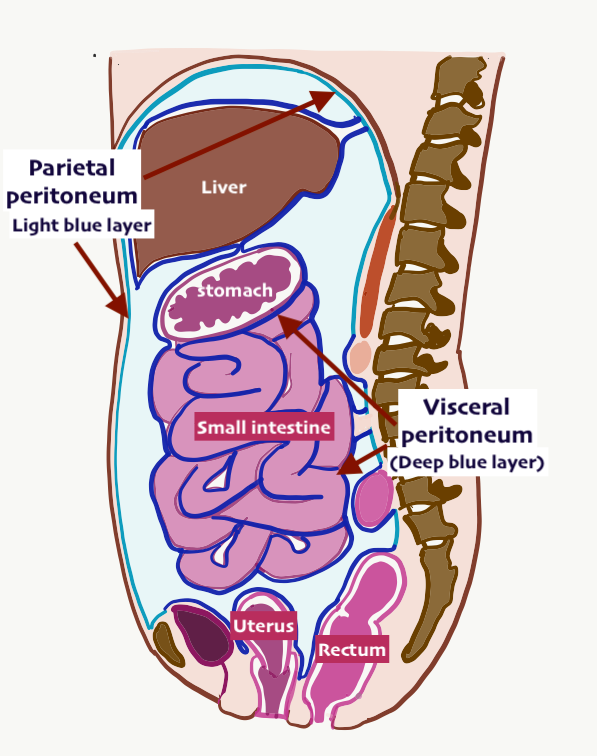
The diagram shows the abdominal cavity, its contents and the peritoneum lining. The deeper blue represents areas of the visceral peritoneum. The lighter shade of blue indicates the parietal peritoneum (lining the wall of the cavity).
What is a Peritoneum?
Peritoneum is a membrane that covers the inside wall of the cavity (parietal peritoneum) and every organ or structure inside it (visceral peritoneum). The space between the visceral and parietal peritoneum, the peritoneal cavity, normally contains a small amount of clear fluid that permits free movement of the viscera (organs), particularly of the intestines, inside the peritoneal cavity.
The abdominal cavity is lined by the peritoneum whose surface is as large as the skin surface, 2 square meters.
The abdominal cavity is the largest hollow space of the body that contains the greater part of the digestive tract (stomach, the small and large intestines), the liver and pancreas, the spleen, the kidneys, and the adrenal glands above the kidneys. The upper boundary of the abdominal cavity is formed by the diaphragm, a sheet of muscle and connective tissue that separates it from the chest cavity. Its lower boundary is the upper plane of the pelvic cavity. Below it, is the pelvic cavity which contains the urinary bladder, the prostate, uterus and vagina along with the rectum (terminal part of the large intestine).Vertically it is enclosed by the vertebral column (spine or backbone) and the abdominal and other muscles.
What is Peritoneal Cancer?
Peritoneal cancer means cancer of the peritoneum. Usually, the tumour deposits are small like rice grains. But sometimes, the deposits can be large, even up-to 5cm or more. Cancer spreading to the peritoneum is considered as stage 4 in most cancers. In ovarian cancer it is stage 2 or 3.
One factor which is more important than the stage, is the extent of spread to the peritoneum. Like the skin that covers the body on the outside, the peritoneum covers the inside of the abdominal cavity and has a large area.
For descriptive purposes, the peritoneum is divided into 13 regions. Surgeons evaluate the amount of disease in each region and give it a score from 0-3 (0 for no tumor and 3 for tumor measuring more than 5 cm in size). The total of the score in all 13 regions determines the peritoneal cancer index or PCI (minimum score or 0 and maximum of 39). The lower the PCI, the better the survival following cytoreductive surgery and HIPEC.
Primary peritoneal cancers have all 4 stages, that is stages I-IV depending on the extent of the spread to the peritoneum.
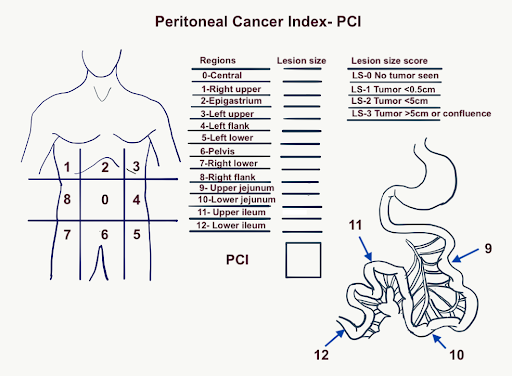
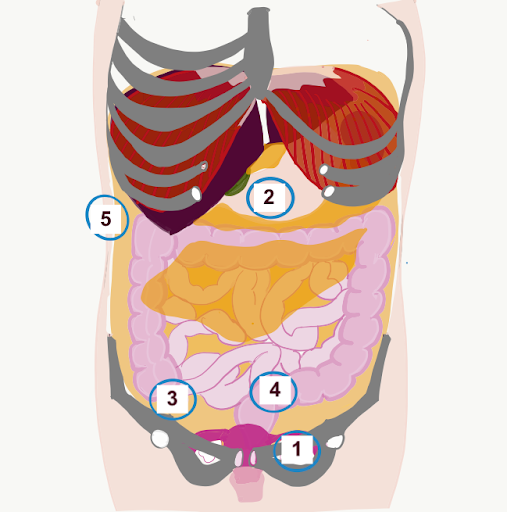
The diagram shows some common origins of peritoneal cancer: 1- ovary; 2- stomach; 3-appendix; 4-colon and rectum; 5- the peritoneum itself.
What are the causes?
A cancer arising in any part of the body can spread to the peritoneum. Such cancers are called secondary peritoneal cancers or peritoneal metastases. The most common cancers that spread to the peritoneum and produce peritoneal cancer or peritoneal metastases are colon and rectum (colorectal) cancer, ovarian cancer, stomach (gastric) cancer and appendix cancer.
In rare situations, the cancer arises from the peritoneum itself and is referred to as primary peritoneal cancer. The two most common primary cancers of the peritoneum are peritoneal mesothelioma and primary peritoneal serous carcinoma (PPSC) that is similar to ovarian cancer.
The cancers in which there is a high incidence of peritoneal deposits are colorectal cancer, ovarian cancer, gastric cancer, appendix, cancers of the gallbladder, liver, pancreas and breast.
What are the Consequences?
Peritoneal cancer can lead to two main complaints:
Formation of ascites (accumulation of fluid in the abdominal cavity)
In individuals who do not have peritoneal cancer, a small amount of fluid is present in the abdominal cavity that lubricates the organs that lie within it. This fluid is being produced continuously, especially by the peritoneum of the small bowel, and is being absorbed continuously as well, especially by the peritoneum of the underside of the diaphragm and by the peritoneum of the omentum.
In peritoneal cancer, there can be an imbalance between production and absorption of fluid, e.g. by blocking of the absorption by the tumor implants, resulting in ascites or excessive accumulation of fluid in the abdominal cavity. The patient notices that he or she is rapidly gaining weight and that the abdomen is swelling.
Ascites caused pain, discomfort, difficulty in breathing, weakness, loss of appetite.
Intestinal Blockade/Obstruction
The tumor implants on the surface of the intestine can cause the intestine to stick to itself and to the abdominal wall, reducing mobility of the bowel and causing sharp angles. The tumor implants at the outside of the intestine can compress the intestine by their volume and block the passage of the intestinal contents. This results in abdominal cramps, vomiting, absent passage of gas and stools, and a swollen abdomen, a condition known as intestinal obstruction/malignant bowel obstruction (MBO). A solitary tumor in the large bowel (colon or rectum) could also block the lumen and cause obstruction. The treatment of this condition which is a different entity is usually surgery or stenting (refer to the section on colorectal cancer)
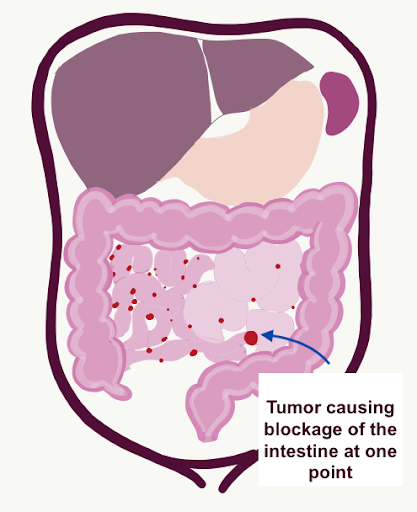
The figure shows the details of calculating the peritoneal cancer index (PCI).
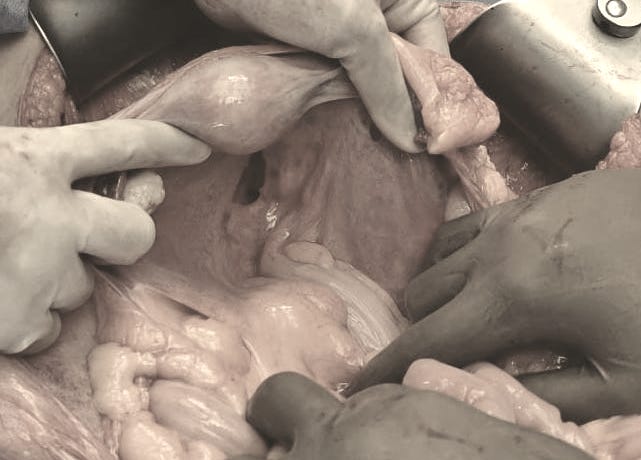
How to treat Peritoneal Cancer?
The classical treatment of peritoneal cancer consisted of intravenous chemotherapy. In case of obstruction, a surgical intervention, such as a bypass between the bowel segment and the segment behind the obstruction, was often carried out.
In case of ascites (peritoneal fluid), medication to reduce the production of fluid and increase its removal from the body was prescribed and fluid was removed from the abdominal cavity to provide symptomatic relief (paracentesis or tapping). With such treatment patients survived 3-18 months and that too with a poor quality of life.
But, in the last 25 years, a new form of treatment was introduced for the management of peritoneal carcinomatosis. This consists of removal of all the gross tumors (cytoreductive surgery ) followed by Hyperthermic Intraperitoneal Chemotherapy (HIPEC ).
Because all stage 4 cancers are not the same, the outcome depends on the extent of tumor spread. Patients in whom the cancer is spread to only one organ, for example the liver in colorectal cancer or the peritoneum in ovarian cancer do better than patients with cancer in more than one organ. Patients with peritoneal implants (tumor deposits) often have cancer spread to the liver or lungs. In some patients however, seeding is limited to the peritoneum.
It is for this subgroup of patients that surgical treatment with cytoreductive surgery and HIPEC may be possible. With this kind of treatment, some patients can have a prolonged life and perform all the activities that people without cancer do.
In a patient with peritoneal cancer, the treatment and outcome depends on:
- Primary tumor site: Patients with colorectal, appendicular, ovarian cancer have a better outcome than other cancers.
- Extent of metastatic spread: When multiple organs have tumor deposits, cure is usually not possible. Patients with disease limited to the peritoneum can be treated aggressively with a greater chance of cure.
- Extent of peritoneal spread: Patients whose peritoneal cancer is very extensive or has spread to other organs as well may not be candidates for cytoreductive surgery and HIPEC . If there are only 2 or 3 tumor deposits in the liver or lung, they can be removed along with removal of the peritoneal disease, but when the disease is more widespread, surgery is not possible.
